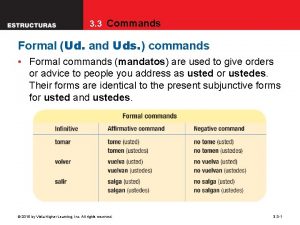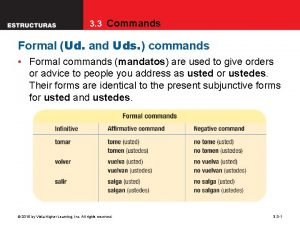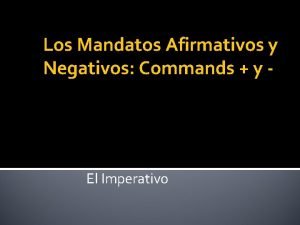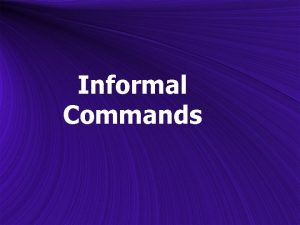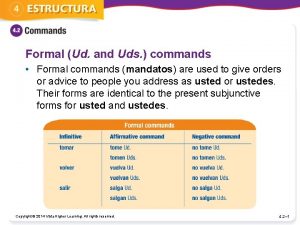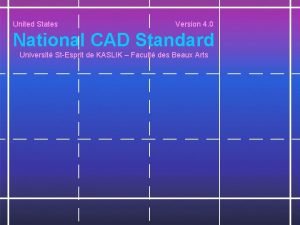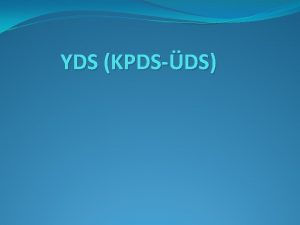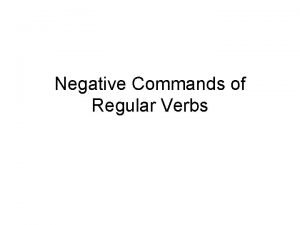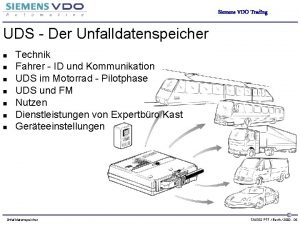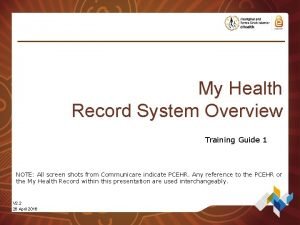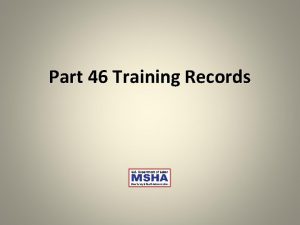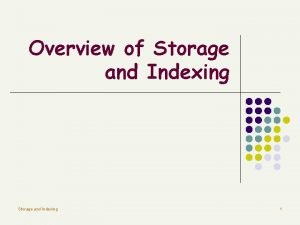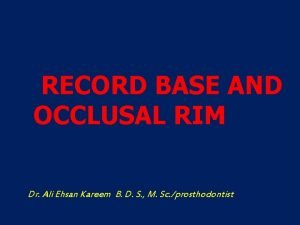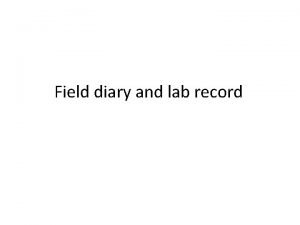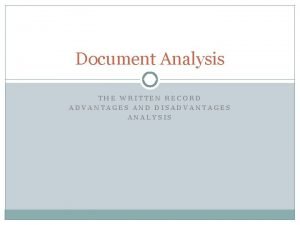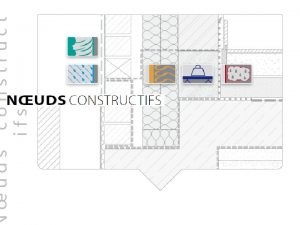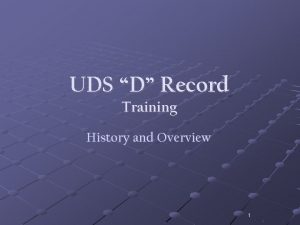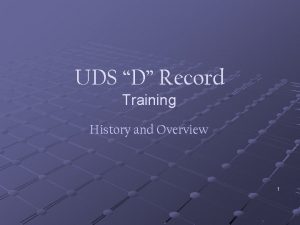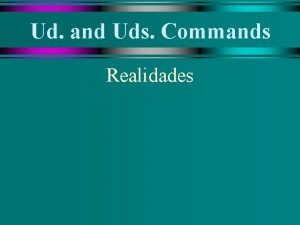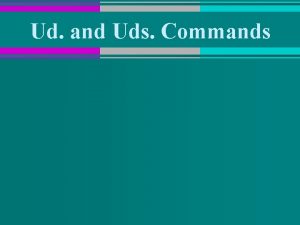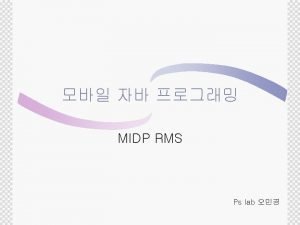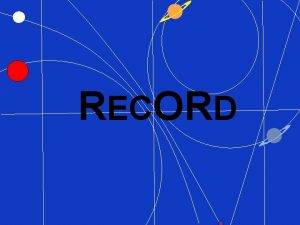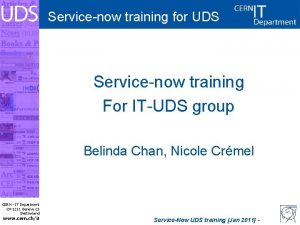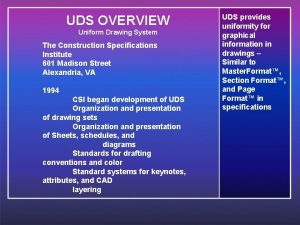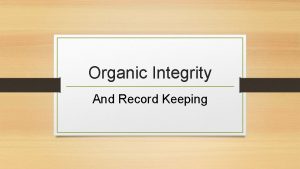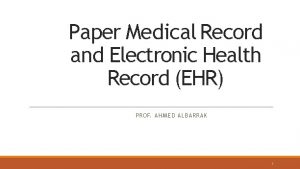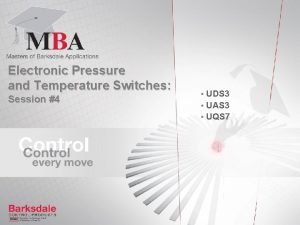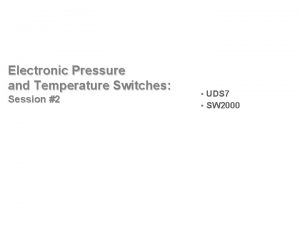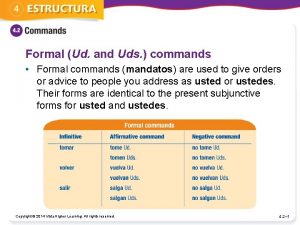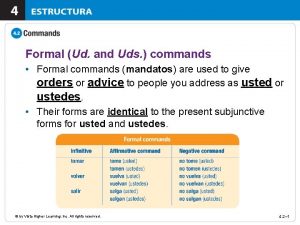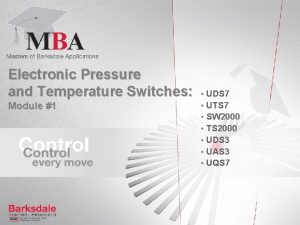UDS D Record Training History and Overview 1





































- Slides: 37

UDS “D” Record Training History and Overview 1

Credits Project Manager – Julie Snyder UDS “D” Record Training Subcommittee James Hamilton (Home Ins. Co. , in Liquidation) – cochair Kathy Lavin (GFMS) Mark Might (Ohio & West Virginia IGA’s) – co-chair Darin Miller (Ohio & West Virginia IGA’s) Paul Radel (Reliance Ins. Co. , in Liquidation) Dale Stephenson (DFS Consulting) NCIGF Support Staff Nick Crews Maureen Sciame Andrew Holladay 2

Mission Statement Simplify Reporting in a Standardized Format versus Multiple Formats Currently Utilized n n n Standardize financial reporting Reduce the number of report formats Simplify the reporting process Move to an Electronic Filing (preferred) versus Hard Copy n n n Ease of creating reports Speed in creating reports Reduction of calculation errors 3

“D” Record Overview History/Background n n n The formation of property/casualty guaranty funds began in the early 70’s. By the mid 80’s, when guaranty funds were becoming a factor in the insolvency process, most still maintained books and records which were largely manual. As insolvencies became larger and encompassed multiple states, guaranty funds started to automate their systems. After implementation of the UDS claim format (April 1, 1995), it was also recognized that the financial reporting by guaranty funds to receivers should be matched to the standardized claim reports, with the added elements of expense that were administrative in nature and therefore not included in the transaction based claim reports. 4

“D” Record Overview History/Background (cont’d) n n The “D” Record was designed to standardize the claims-related and administrative expense data requested, providing for efficiency, reconcilability and ease of use by both guaranty funds and receivers. In December 2007, the new “D” Record for financial reporting was approved by the NAIC with reconciliation capabilities for historical, non-detailed segments and with new features for future reporting. 5

“D” Record Overview Benefits n Guaranty Funds Standardized reporting reduces the variety of formats required to be completed Increases the opportunity to automate the process Reduces manpower needs to compile the report Speeds up the preparation and issuance of the financial report n Receiverships Facilitates the compilation of financial data from multiple GFs. Speeds up reconciliation with the “C” Record and Revenue sections Allows for review and analysis of claim costs Allows for review and analysis of individual GF Proofs of Claims 6

“D” Record Overview Costs n n Review and changes to general ledger accounts Initial costs for the change over and time to reconcile between prior reporting formats and the new “D” record 7

“D” Record Overview Reconciliation n Guaranty Funds Prior to submitting the “D” Record to the receiver: • The guaranty fund should reconcile the “D” Record, Section 1 to the “C” Record. Any differences found during this reconciliation need to be corrected an itemized report should be sent to the receiver. This will assist the receiver in expediting their reconciliation. • The guaranty fund should reconcile Year-to-Date and Inception-to-Date amounts in Section 2 and the Revenue Section to the prior quarter report. 8

“D” Record Overview Reconciliation n Receiverships The receiver should reconcile the “D” Record, Section 1 to the “C” Record. The receiver should reconcile Year-to-Date and Inception-to-Date amounts in Section 2 and the Revenue Section to prior quarter report. If any differences are found during this reconciliation, the receiver should contact the guaranty fund. 9

Section I Guaranty Fund IT Staff Other Considerations System Considerations 10

Process The Guaranty Fund exports information from its General Ledger and presents it within the appropriate “D” Record categories. The resulting “D” Record is then transmitted to the Liquidator. General Ledger (G/L) Export G/L Data Create UDS “D” Records Transmit Liquidator Receives Records 11

Other Considerations As stated in the Mission Statement, the short term goal relates to standardization and simplicity. The long term goal relates to automation. In instances where the guaranty fund provides an electronic UDS “D” Record and the receiver elects to utilize the electronic file, the following other considerations apply: Record mapping will have to identify the corresponding G/L Account Mapping n n Consideration must also be given to multiple G/L accounts which roll into one UDS code or category. Excel spreadsheet templates will be available to assist in creating a hard copy “game plan. ” 12

Other Considerations (cont’d) Consideration must be given to cut-off dates, with the ultimate goal of having the financial cut-off being consistent with the claims cut-off. n n Allows automation of reconciling the “D” Record with the “C” Record. Eliminates the need for manually reconciling any gap between cut-off dates. 13

Preparing the Data is collected for: n n n Current Quarter Year-to-Date Inception-Date Every effort should be made to use the same cut-off period for both Financial Reconciliation and Claims Reconciliation. This will eliminate the need for manual reconciliation. 14

Establish an Account Map that links organization’s accounting codes to their UDS counterparts n Utilize template to accomplish mapping Extra rows are provided in the event that multiple G/L Accounts roll into one UDS code 15

System Considerations UDS Financial Manual Header Detail Records Trailer Format specifications are defined in the UDS Financial Manual 16

System Considerations As stated in the Mission, the short term goal relates to standardization and simplicity. The long term goal relates to automation. In instances where the guaranty fund provides an electronic UDS “D” Record and the receiver elects to utilize the electronic file, the following system considerations apply: “D” Record Format specifications are spelled out in the UDS Financial Manual n n Accounting software must be able to export data. System software must be developed to allow exported data to be entered into the appropriate UDS “D” Record fields and store the data electronically. 17

System Considerations (cont’d) Quality Control Checks n n Consideration needs to be given to utilization of front end edits to screen invalid and/or illogical data. Utilization of Header and Trailer Records helps ensure data is consistent with the expectations defined in the “D” Record format specifications. Upload Data to Receiver n Consideration must be given to the secure transmission of the UDS “D” Record from Guaranty Fund to Receiver. 18

Section II Receiver IT Staff System Considerations Other Considerations 19

Process The Liquidator receives “D” Records from GFs and loads them into G/L, Administrative Database or Proof of Claim System. . Liquidator Receives Records Imports Claims and G/L Data Into Liquidator’s Loading Program Run Pre-load Quality Control Reports and Check Trailer Report Totals Match Section 1 Totals to the “C” Record Totals Create Analysis Reports Load Data into Liquidator’s Database 20

System Considerations “D” Record Format specifications are spelled out in the UDS Financial Manual n n Consideration will need to be given to design and development of an IT facility to accept the electronic file and possibly load the information into a receivership’s administrative database. System software will need to be developed to read the file and store the data electronically. Front-end Edits/Header and Trailer Records n n Consideration needs to be given to utilization of front end edits to screen invalid and/or illogical data. Consideration needs to be given to utilization of header and trailer records for reconciliation and balancing routines. 21

System Considerations (cont’d) Quality Control Checks n n Consideration needs to be given to design of controls to ensure that data per the UDS “D” Record is accurately populated into the Receiver’s G/L or Administration database. Reconciliation and balancing routines need to be developed. 22

Other Considerations Receivers will have varying processes and procedures for receipt, review and utilization of UDS “D” Record information, whether they obtain the information via electronic file, electronic spread sheet or paper format. The following are some other considerations that may apply to their situation: Identify UDS “D” Record mapping to corresponding Receiver’s G/L Account mapping n n One or multiple fields on the UDS “D” Record may need to be mapped into a single field on the Receiver’s G/L or Administration Database. Consideration will need to be given to programming requirements should this mapping be performed electronically. 23

Other Considerations (cont’d) Load data into G/L, Administrative Database or Proof of Claim System n n n Consideration needs to be given as to whether data per the UDS “D” Record will be loaded into the Receiver’s G/L, Administrative Database or Proof of Claim System. Consideration needs to be given to IT requirements including identification of selected fields of UDS “D” Record data that will be populated into the Receiver’s Administrative Database. Once the database is populated, consideration needs to be given to IT requirements to program ad hoc reports for data analysis purposes 24

Header 25

Detail Records 26

Detail Records (cont’d) 27

Detail Records (cont’d) 28

Detail Records (cont’d) 29

Detail Records (cont’d) 30

Detail Records (cont’d) 31

Detail Records (cont’d) 32

Detail Records (cont’d) 33

Trailer 34

Trailer (cont’d) 35

Trailer (cont’d) 36

Questions? udshelp@udstsg. com 37
 Uds commands
Uds commands Uds commands
Uds commands Anecdotal record vs running record
Anecdotal record vs running record Afirmativo y negativo mandatos
Afirmativo y negativo mandatos 3 recipients of informal commands
3 recipients of informal commands Uds commands
Uds commands Uds cad
Uds cad Uds pronoun
Uds pronoun Mandatos tu afirmativos y negativos
Mandatos tu afirmativos y negativos üds nedir kimler girebilir
üds nedir kimler girebilir Informal commands spanish
Informal commands spanish Vdo trading
Vdo trading Dar negative tu command
Dar negative tu command Design history record
Design history record Sra skills standards
Sra skills standards Trainee solicitor training record
Trainee solicitor training record My health record training
My health record training Msf4343
Msf4343 New miner training record/certificate
New miner training record/certificate Also history physical
Also history physical Temple family history consultant
Temple family history consultant Training is expensive without training it is more expensive
Training is expensive without training it is more expensive Metode of the job training
Metode of the job training Aggression replacement training facilitator training
Aggression replacement training facilitator training Overview of transcription and translation
Overview of transcription and translation Data quality and data cleaning an overview
Data quality and data cleaning an overview Nitrogen group
Nitrogen group An overview of data warehousing and olap technology
An overview of data warehousing and olap technology What is bioinformatics an introduction and overview
What is bioinformatics an introduction and overview An overview of data warehousing and olap technology
An overview of data warehousing and olap technology Data quality and data cleaning an overview
Data quality and data cleaning an overview Data quality and data cleaning an overview
Data quality and data cleaning an overview Overview of storage and indexing
Overview of storage and indexing Chapter 17 overview elements and their properties
Chapter 17 overview elements and their properties Importance of recording and reporting in nursing
Importance of recording and reporting in nursing Uses of occlusal rim
Uses of occlusal rim Field diary and lab record
Field diary and lab record Unstructured observation
Unstructured observation
